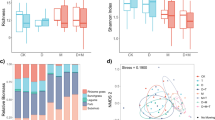Abstract
To investigate the effect of increased nutrient availability on competition amongst invasive and native plants, I measured changes in above and below ground biomass of Chrysanthemoides monilifera spp. rotundata (bitou bush) and Asparagus aethiopicus (asparagus fern) competing with two native species, Banksia integrifolia and Ficinia nodosa, under high- and low-nutrient regimes. Bitou bush, as a primary invader, was competitive under all conditions lowering the growth of native species in both high and low nutrients. Asparagus fern as a secondary invader, did not influence growth of native species but responded, like bitou bush, to high nutrients. Native species were generally negatively affected by increases in nutrients. With bitou bush soils often providing higher nutrients, the chance of secondary invasion by asparagus fern is more likely, although asparagus fern is unlikely to invade low nutrient soils quickly. The invasive species, therefore, differed in their competitive ability in these coastal dune communities.


Similar content being viewed by others
References
Blanchard R, Holmes PM (2008) Riparian vegetation recovery after invasive alien tree clearance in the Fynbos Biome. S Afr J Bot 74:421–431
Burke MJW, Grime JP (1996) An experimental study of plant community invasibility. Ecology 77:776–790
Daehler CC (2003) Performance comparisons of co-occurring native and alien invasive plants: implications for conservation and restoration. Ann Rev Ecol Evol Syst 34:183–211
Ens EJ, French K, Bremner JB (2009a) Evidence for allelopathy as a mechanism of community composition change by an invasive exotic shrub, Chrysanthemoides monilifera spp. rotundata. Plant Soil 316:125–137
Ens EJ, Bremner JB, French K, Korth J (2009b) Identification of volatile compounds released by roots of an invasive plant, bitou bush (Chrysanthemoides monilifera spp. rotundata), and their inhibition of native seedling growth. Biol Invasions 11:275–287
French K, Mason TJ, Sullivan N (2011) Recruitment limitation of native species in invaded coastal dune communities. Plant Ecol 212:601–609
Gonzalez-Munoz N, Costa-Tenorio M, Espigares T (2012) Invasion of alien Acacia dealbata on Spanish Quercus robur forests: impact on soils and vegetation. Forest Ecol Manag 269:214–221
Hagos MG, Smit GN (2005) Soil enrichment by Acacia mellifera subsp. detinens on nutrient poor sandy soil in a semi-arid southern African savanna. J Arid Environ 61:47–59
Hierro JL, Callaway RM (2003) Allelopathy and exotic plant invasion. Plant Soil 256:29–39
Hobbs RJ, Huenneke LF (1992) Disturbance, diversity, and invasion: implications for conservation. Conserv Biol 6:324–337
Huenneke LF, Hamburg SP, Koide R, Mooney HA, Vitousek PM (1990) Effects of soil resources on plant invasion and community structure in Californian serpentine grassland. Ecology 71:478–491
Lake JC, Leishman MR (2004) Invasion success of exotic plants in natural ecosystems: the role of disturbance, plant attributes and freedom from herbivores. Biol Conserv 117:215–226
Li Y, Norland M (2001) The role of soil fertility in invasion of Brazilian Pepper (Schinus terebinthifolius) in Everglades National Park, Florida. Soil Sci 166:400–405
Lindsay EA, French K (2004) Chrysanthemoides monilifera ssp. rotundata invasion alters decomposition rates in coastal areas of New South Wales. Australia. Forest Ecol Manag 198:387–399
Lindsay EA, French K (2005) Litterfall and nitrogen cycling following invasion by Chrysanthemoides monilifera ssp. rotundata in coastal Australia. J Appl Ecol 42:556–566
Magesan GN, Wang H, Clinton PW (2012) Nitrogen cycling in gorse-dominated ecosystems in New Zealand. NZ J Ecol 36:21–28
Mason TJ, French K (2007) Management regimes for a plant invader differentially impact resident communities. Biol Conserv 136:246–259
Mason TJ, French K, Russell K (2012) Are competitive effects of native species on an invader mediated by water availability? J Veg Sci 23:657–666
Sharma GP, Muhl SA, Esler KJ, Milton SJ (2010) Competitive interactions between the alien invasive annual grass Avena fatua and indigenous herbaceous plants in South African Renosterveld: the role of nitrogen enrichment. Biol Invasions 12:3371–3378
Vitousek PM, Walker LR (1989) Biological Invasions by Myrica faya in Hawaii: plant demography, nitrogen fixation, ecosystem effects. Ecol Monogr 59:247–265
Wedin D, Tilman D (1993) Competition among grasses along a nitrogen gradient: initial conditions and mechanisms of competition. Ecol Monogr 63:199–229
Williamson M, Fitter A (1996) The varying success of invaders. Ecology 77:1661–1666
Witkowski ETF (1991) Growth and competition between seedlings of Protea repens (L) L and the alien invasive, Acacia saligna (Labill) Wendl. in relation to nutrient availability. Funct Ecol 5:101–110
Acknowledgments
This study was funded by the Hermon Slade Foundation and Defeating the Weeds Menace, Land and Water Australia. Emilie Ens, Natalie Sullivan, Tanya Mason helped in discussions and experimental work. Thanks to Hillary Cherry, MaryAnn Vinton and Ben Gooden for helpful comments on the manuscript.
Author information
Authors and Affiliations
Corresponding author
Rights and permissions
About this article
Cite this article
French, K. Competition strength of two significant invasive species in coastal dunes. Plant Ecol 213, 1667–1673 (2012). https://doi.org/10.1007/s11258-012-0122-5
Received:
Accepted:
Published:
Issue Date:
DOI: https://doi.org/10.1007/s11258-012-0122-5




